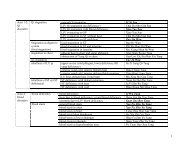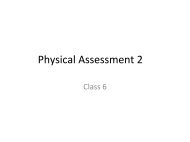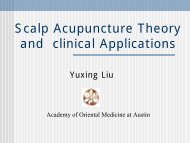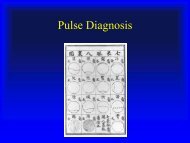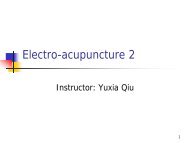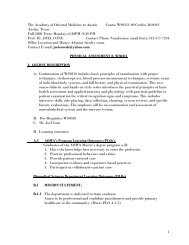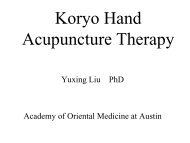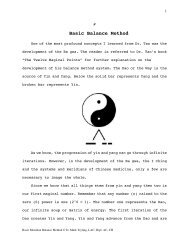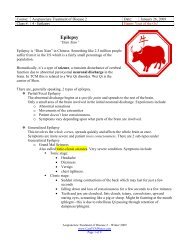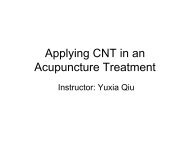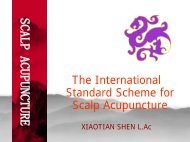Pharmacology Class 3-4 - autonomic nervous ... - CatsTCMNotes
Pharmacology Class 3-4 - autonomic nervous ... - CatsTCMNotes
Pharmacology Class 3-4 - autonomic nervous ... - CatsTCMNotes
Create successful ePaper yourself
Turn your PDF publications into a flip-book with our unique Google optimized e-Paper software.
Course: Biomedical <strong>Pharmacology</strong> Date: October 5/12, 2009<br />
<strong>Class</strong> #: 3-4 – Autonomic (Sympathetic/Parasympathetic) System Prof: Raja Mandayam<br />
Terminology<br />
Acetylcholine (ACh) – neurotransmitter<br />
of parasympathetic (aka cholinergic)<br />
nerves. Stimulates the cholinergic<br />
receptors.<br />
Adrenergic receptors – receptor located<br />
on internal organs, response to<br />
norepinephrine.<br />
Afferent nerve - sends sensory info<br />
from body to CNS.<br />
Autonomic <strong>nervous</strong> system (ANS) -<br />
innervates involuntary muscles (smooth<br />
and cardiac muscle of internal organs).<br />
Cholinergic receptor - located on<br />
internal organs, responds to ACh. Part of<br />
parasympathetic system.<br />
Efferent nerve – carries motor response<br />
from CNS to appropriate motor area of<br />
body.<br />
Epinephrine – hormone from adrenal<br />
medulla. Stimulates<br />
adrenergic/sympathetic receptors, esp<br />
during stress.<br />
Fight or flight – body response to stress,<br />
occurs when sympathetic <strong>nervous</strong><br />
system (part of ANS) fires up.<br />
Homeostasis – normal state of balance in<br />
Autonomic System<br />
The <strong>nervous</strong> system of the body is divided into 2 major divisions, one of which has several other<br />
divisions. The primary divisions are the Central Nervous System or CNS and the Autonomic Nervous<br />
System or the ANS. You should be familiar with both to<br />
understand how pharmaceutical agents affect the body. The one<br />
we are primarily going to study is the Autonomic Nervous System,<br />
but read about the CNS anyway because it’s still pertinent to the<br />
discussion.<br />
1. CNS – Central Nervous System<br />
That’s the brain and the spinal cord. The system receives<br />
sensory input from the body from the afferent nerves,<br />
decides what to do about them, and then sends the decision<br />
and appropriate motor responses via the peripheral efferent<br />
nerves.<br />
The Reticular Activating System, part of the CNS, is<br />
situated at the core of the brain stem between the medulla<br />
oblongata and the midbrain. It is responsible for<br />
maintenance of consciousness, wakefulness and alertness.<br />
It also regulates the cardiovascular and respiratory systems<br />
as well as sexual patterns. When this system is disturbed<br />
the sleep cycle can also be disturbed. This system is<br />
affected by psychotropic drugs, general anesthetics and<br />
melatonin.<br />
The Limbic System, also part of the CNS is a set of brain<br />
components including the hippocampus, amygdala,<br />
anterior thalamic nuclei, and limbic cortex. It supports<br />
functions such as emotion, behavior, long term memory,<br />
and the sense of smell. One part is involved in reward,<br />
pleasure and addiction, another in decision making. If you<br />
want the whole list and what each component does, check<br />
this link out.<br />
2. PNS – Peripheral Nervous System<br />
This includes the 12 cranial nerves which we’ve had to relearn about 4 times now and 31 pairs of<br />
spinal nerves which is what you’re affecting when you needle Jiaji points. The PNS is further<br />
divided into 2 subdivisions:<br />
<strong>Pharmacology</strong> – Fall 2009<br />
www.<strong>CatsTCMNotes</strong>.com<br />
Page 1 of 17
a. Somatic/Motor<br />
This is the part that activates the voluntary muscles – your biceps, triceps, thighs, calves,<br />
and some components of your naughty bits. (There’s also an EPS or Extra Pyramidal<br />
System which controls fine motor movements.) The somatic system is under your<br />
conscious control.<br />
b. Autonomic<br />
This is the part that runs your involuntary muscles – cardiac and smooth muscle in your<br />
internal organs…and some other parts of your naughty bits. This is the stuff that is not<br />
under your conscious control (unless you’re a meditating monkish sort), but is instead<br />
regulated by the hypothalamus and medulla oblongata, the more primitive parts of your<br />
brain.<br />
This is the subsystem we’re really going to hammer on in this unit of pharmacology<br />
because you need to understand how drugs affect the two divisions of the <strong>autonomic</strong><br />
<strong>nervous</strong> system, the sympathetic and parasympathetic <strong>nervous</strong> systems.<br />
The Physiology of the Autonomic Nervous System (ANS)<br />
The ANS regulates homeostasis, the balance among the body’s internal<br />
organs by regulating the smooth and cardiac muscle found in the internal<br />
organs. The parasympathetic division of the ANS is also known as the<br />
cranio-sacral division. It originates from the brain at cranial nerves 3, 7,<br />
9, and 10 and from the spinal cord’s sacral nerves S2-S4. The<br />
sympathetic division, also referred to as the thoracolumbar division. The<br />
sympathetic/thoracolumbar division originates from the thoracic and<br />
lumbar spinal nerves, T1 to L3.<br />
The sympathetic system increases the activity of certain organs and<br />
depresses others during times of stress or duress in order to generate the<br />
“fight or flight” reaction to make more energy available for physical and<br />
mental action. While you don’t often have a T-Rex chasing you these days<br />
you probably have daily stress and anxiety (and the occasional illness)<br />
which produce similar reactions. When the sympathetic <strong>nervous</strong> system is<br />
stimulated it’s all or nothing and all sympathetic nerves are activated at<br />
once. The parasympathetic system is more active during periods of “rest<br />
and digest,” regulating bodily functions such as digestion and elimination<br />
of waste. Unlike the sympathetic division, when the parasympathetic<br />
<strong>nervous</strong> system is stimulated only select nerves are active.<br />
Parasympathetic - ANS<br />
nerves originating the brain and<br />
sacral part of the spinal cord.<br />
Active when the body is at rest,<br />
works to restore the body’s<br />
energy and functions. It’s the<br />
“rest and digest system.<br />
Sympathetic – ANS nerves<br />
originating in the thoracic and<br />
lumbar part of the spinal cord.<br />
Active when the body is under<br />
stress or exerting energy.<br />
Neurotransmitter – chemical<br />
compounds made in the body<br />
which relay, amplify and<br />
modulate communications<br />
between neurons and cells. The<br />
produce changes associated<br />
with the sympathetic and<br />
parasympathetic divisions.<br />
So how does this happen? First, neurons emerge from the spinal cord. These are called preganglionic<br />
nerves. The ones in the sympathetic <strong>nervous</strong> system happen to be shorter than those in the<br />
parasympathetic system. The preganglionic nerves exit the spinal column and meet at ganglions<br />
(bundles of nerve synapses in the peripheral <strong>nervous</strong> system) where they connect with postganglionic<br />
nerves. These nerve endings aren’t physically joined. There is a small gap between them so they<br />
<strong>Pharmacology</strong> – Fall 2009<br />
www.<strong>CatsTCMNotes</strong>.com<br />
Page 2 of 17
communicate through chemical compounds called neurotransmitters. The postganglionic fibers travel<br />
to the target tissues where more neurotransmitters stimulate the internal organs and target tissues.<br />
The primary neurotransmitter in the parasympathetic system is ACH or acetylcholine. Nerves that<br />
release ACH are called cholinergic. The sympathetic system uses the neurotransmitter ACH too, but<br />
also employs adrenalin or epinephrine, norepinephrine/noradrenaline, dopamine, and serotonin or 5-HT.<br />
Nerves that release adrenaline or noradrenaline are called adrenergic nerves. When there is a releaser<br />
there is always a receptor for the neurotransmitter. Receptors that receive ACH/acetylcholine are called<br />
cholinergic receptors while the ones receiving adrenaline and norepinephrine are called adrenergic<br />
receptors.<br />
Drugs Affecting the Sympathetic Nervous System<br />
Adrenergic Nerve Endings and Receptors<br />
It’s the nerve endings that store the adrenergic neurotransmitters. Mostly they are referred to as NE (for<br />
norepinephrine) and EPI (for epinephrine). When the nerve is stimulated a neurotransmitter is released.<br />
In the case of NE, it travels to smooth or cardiac muscle and attaches to the receptor producing the<br />
sympathetic response. It is then reabsorbed (called “reuptake) back into the nerve endings. Sometimes it<br />
is reused, sometimes it’s destroyed. When EPI is released it either inhibits or relaxes smooth muscle in<br />
certain organs. In the case of the lungs, it causes bronchodilation by relaxing the respiratory<br />
passageways allowing the body to take in more oxygen. That’s important because if you’re in fight or<br />
flight mode, you need oxygen for both!<br />
There are two kinds of adrenergic receptors: alpha and beta. The alphas are mostly in smooth muscle<br />
and contract when stimulated by NE or EPI.<br />
Alpha Adrenergic Receptors<br />
Found mostly in smooth muscle. Stimulated by NE or EPI. Produce contraction.<br />
Beta Adrenergic Receptors<br />
Found on cardiac and some smooth muscle membranes.<br />
☯ Cardiac<br />
Mostly Beta 1 receptors.<br />
Can be stimulated by NE or EPI. Results in increase in heart rate/force of contraction<br />
☯ Smooth muscle<br />
Mostly Beta 2 receptors.<br />
Can only be stimulated by EPI (not NE). Results in:<br />
o Vasodilation in skeletal muscle/ blood vessels/ coronary arteries<br />
o Bronchodilation (relaxation)<br />
What this means in terms of drugs<br />
Two main classes of drugs affecting the sympathetic <strong>nervous</strong> system: sympathomimetics and<br />
sympatholytics. More detail on these in the next section, but here’s your 101.<br />
<strong>Pharmacology</strong> – Fall 2009<br />
www.<strong>CatsTCMNotes</strong>.com<br />
Page 3 of 17
Sympathomimetics<br />
Basically, these mimic the stimulation of the sympathetic <strong>nervous</strong> system. They produce an<br />
increase in BP, heart rate and dilate the bronchioles. They are used for shock, cardiac arrest and<br />
respiratory distress for this reason.<br />
Alpha Adrenergic Drugs<br />
If it stimulates the alpha receptors you call it an “alpha-adrenergic” drug. This includes<br />
both NE and EPI which cause contraction of smooth muscle.<br />
Beta Adrenergic Drugs<br />
If an adrenergic drug stimulates the beta receptors they are called “beta-adrenergic<br />
drugs.” They affect both Beta 1 and Beta 2 receptors.<br />
☯ EPI can also stimulate the heart’s beta 1 receptors as well as cause relaxation of<br />
smooth muscle by stimulating beta 2 receptors. EPI is weird this way – it’s one of<br />
the few that does both alpha and beta.<br />
☯ Selective Beta 2 Adrenergic Drugs are special in that they only stimulate beta 2<br />
receptors at therapeutic doses, dilating the bronchioles.<br />
Sympatholytics<br />
Anything ending in –lytic block the activity of a system, inhibiting the sympathetic system. In<br />
this case it refers to blocking and thus decreasing sympathetic activity, especially in the<br />
cardiovascular system. How? Glad you asked. They compete with NE and EPI for receptor sites<br />
– basically they lose at musical chairs. If they can’t get their butts in the seats (receptor sites)<br />
then there’s no message for the sympathetic system to fire up.<br />
They decrease BP and heart rate. They are used for hypertension, angina pectoris and some types<br />
of cardiac arrhythmias. There are a couple of flavors of these:<br />
Alpha Adrenergic Blockers<br />
Block alpha effects of NE and EPI<br />
Non-selective Beta-Adrenergic Blockers<br />
Block beta1 and beta2 effects of EPI<br />
Selective Beta-1 Adrenergic Blockers<br />
Block only Beta 1 receptor sites.<br />
Adrenergic Neuronal Blockers<br />
OK, there is actually one other way to inhibit the sympathetic <strong>nervous</strong> system. You can<br />
simply decrease the formation of or the release of NE. Drugs that do this are called<br />
adrenergic neuronal blockers.<br />
<strong>Pharmacology</strong> – Fall 2009<br />
www.<strong>CatsTCMNotes</strong>.com<br />
Page 4 of 17
Alpha Adrenergic <strong>Class</strong> of Drugs<br />
Again, these are sympathomimetics, stimulating the sympathetic <strong>nervous</strong> system. NE is the<br />
parent/prototype for this class and alpha drugs produce very similar effects, namely contraction of<br />
smooth muscle, including vasoconstriction in blood vessels, gastrointestinal sphincters, and muscle in<br />
urinary passage. It also dilates the pupil of the eye (mydriasis).<br />
Clinical Indications<br />
Used intravenously usually for hypotensive states. Examples:<br />
☯ Post-surgical - increase BP and keep circulation working<br />
☯ Decongestant effect – vasoconstriction in nasal passages. That’s why OTC cold and allergy<br />
meds have some of this in them.<br />
☯ Ophthalmology – dilates pupils (also called a “mydriatic drug” since mydriasis means to<br />
dilate the pupils). Also used as an “ocular decongestant.”<br />
☯ Appetite suppressant – the ones that pass the blood brain barrier can do this. Amphetamines<br />
for instance. Dexadrine was popular in my youth for this…and that dates me big time<br />
because you can’t just walk into HEB and pick that stuff up anymore!<br />
Endings are –ine and –ol.<br />
Generic Trade name Main Use Dosage Forms<br />
Ephedrine Nasal decongestant Capsule, parenteral inject<br />
Metaraminol Aramine Increase BP Parenteral injection<br />
Methoxamine Vasoxyl Increase BP Parenteral injection<br />
Norepinephrine Levophed Increase BP Parenteral injection<br />
Phenylephrine Lots of names Nasal decongestant Spray, drops, tabs, inject<br />
Pseudoephedrine Many of ‘em Nasal decongestant Tabs, caps, oral liquids<br />
Tetrahydrozoline Visine Ophthalmic decongestant Ocular/eye drops<br />
Tetrahydrozoline Tyzine Nasal decongestant Nasal drops<br />
And yes, that last one is the same generic name twice in 2 different forms.<br />
Adverse Effects<br />
The unwanted effects have to do with excessive vasoconstriction of vessels resulting in:<br />
☯ Cardiac side effects such as hypertension, hypertensive crisis, heart palpitations, cardiac<br />
arrhythmias<br />
☯ Cerebral hemorrhage<br />
This is why you have to be very careful using it with patients who have hypertension or history of<br />
cardiac problems. Check their BP at frequent intervals.<br />
Another common, though non-dramatic side effect when using it as a decongestant is irritation of<br />
nasal tissues or eyes. The vasoconstriction and reduced blood flow causes dryness here.<br />
Caution: if administered in IV form, needle should be checked to make sure it isn’t emptying into the<br />
skin surface. This can cause enough constriction to kill off the tissue and cause gangrene.<br />
<strong>Pharmacology</strong> – Fall 2009<br />
www.<strong>CatsTCMNotes</strong>.com<br />
Page 5 of 17
Beta Adrenergic <strong>Class</strong> of Drugs<br />
These are sympathomimetics, stimulating the sympathetic <strong>nervous</strong> system. Their specific action is to<br />
link to beta receptors. Most produce few alpha effects, except for EPI. Beta-1’s stimulate the heart and<br />
beta-2’s stimulate and dilate the bronchioles. If you don’t use a specific beta adrenergic but instead use<br />
something like EPI or isoproterenol you will open the bronchioles, but possibly over stimulate the heart.<br />
While there are no beta-1 specific drugs, there are a number of beta-2 specifics to use for<br />
bronchodilation only.<br />
Clinical indications for EPI<br />
EPI is primarily used for acute allergic reactions like anaphylaxis. Anaphylaxis can occur when<br />
an individual has been sensitized to something such as insect stings, drugs or other allergens<br />
(though Dr. Mandyam said in class it was stings only…) Signs of anaphylaxis are:<br />
☯ Dyspnea<br />
☯ Decreased blood pressure<br />
☯ Signs of shock<br />
EPI is administered subcutaneously, stimulating both alpha and beta receptors. Alpha actions are<br />
also used during surgery or combined with local anesthetics to constrict the vessels, decreasing<br />
blood flow and bleeding. It also makes the local work longer for the same reason. Beta effects<br />
are used for cardiac stimulation and bronchodilation in emergency situations. Both EPI and<br />
isoproterenol are available OTC for asthma type rescue inhalers.<br />
All end in –ine or –ol.<br />
Generic Trade name <strong>Class</strong> Main use<br />
Epinephrine Adrenaline Alpha, beta-1, beta-2 Vasopressor, cardiac stim, bronchodilator<br />
Isoproterenol Isuprel Beta-1 and beta-2 Cardiac stim, bronchodilator<br />
Isoetharine Bronkometer Beta-2 Bronchodilator<br />
Metaproterenol Alupent Beta-2 Bronchodilator<br />
Terbutaline Brethine Beta-2 Bronchodilator<br />
Albuterol Proventil and Beta-2<br />
Bronchodilator<br />
ventolin<br />
Fenoterol Berotec Beta-2 Bronchodilator<br />
Salmeterol Serevent Beta-2 Bronchodilator<br />
Adverse Effects<br />
☯ Betas can produce overstimulation of the CNS thus tremors, restlessness, anxiety.<br />
☯ Overstimulation of the heart/cardiac arrhythmias – bigger danger with older beta drugs<br />
such as EPI and isoproterenol. Use extreme caution if patient has existing heart disease<br />
☯ Hypotension – beta-2 effects dilate the blood vessels of skeletal muscles.<br />
☯ Higher than therapeutic doses of beta-2 specific drugs can stimulate the beta-1 receptors<br />
in the cardiac muscle.<br />
☯ Cardio-vascular effects in pre-term pregnant patients – can arrest preterm labor, but also<br />
can have cardiovascular effects/complications. Fetal heart rate is also affected<br />
<strong>Pharmacology</strong> – Fall 2009<br />
www.<strong>CatsTCMNotes</strong>.com<br />
Page 6 of 17
Dopamine<br />
Not a class, but gets special mention because it is an NT in the brain and is formed in the body’s<br />
production of NE in the peripheral adrenergic/sympathetic nerve endings. If you create it in a lab (like<br />
the drug Intropin) and pump it into an IV you can treat cardio effects in circulatory shock.<br />
The low and moderate dose effects below are important in the treatment of shock. It is used in a drip IV.<br />
Effects cease shortly after the flow of the IV ceases.<br />
Low doses<br />
Stimulates dopaminergic receptors in renal, mesenteric blood vessels. Vasodilation and<br />
increased renal blood flow.<br />
Moderate doses<br />
Stimulates beta-1 receptors, increasing heart contractility and output.<br />
High doses<br />
Stimulates alpha receptors – vasoconstriction. Overdose results in excessive heart<br />
stimulation and increased blood pressure.<br />
Dobutamine, marketed as Dobutrex, is a drug similar to dopamine. Greater beta-1 effects, mainly used<br />
for heart failure in and IV infusion.<br />
Alpha-Adrenergic Blocking Drugs<br />
Sympatholytics, inhibiting the sympathetic <strong>nervous</strong> system. These compete with NE for binding rights<br />
to the receptors. If they beat the NE to the receptor, NE doesn’t produce sympathetic responses, so<br />
organs with alpha receptors have decreased sympathetic response.<br />
The primary alpha organ: the blood vessels.<br />
The result: vasodilation and lower blood pressure.<br />
Clinical Indications<br />
☯ Hypertension<br />
☯ Peripheral vascular problems with poor blood flow to skin/extremities like Reynaud’s<br />
disease.<br />
☯ Diagnosis of pheochromocytoma (tumor on adrenal medulla increased catecholamine and<br />
severe hypertension).<br />
☯ Diagnosis and treatment of benign prostatic hyperplasia causing enlargement of prostate<br />
gland and difficult urinary flow<br />
Note that all end in –in or –ine.<br />
Generic Trade name Main use Common daily dose<br />
Doxazosin Cardura HTN, benign prostatic hyperplasia 1 – 16mg po, 1-8mg po<br />
Phentolamine Regitine Pheochromocytoma – diagnosis 5mg IV<br />
Prazosin Minipress HTN 1 – 20 mg po<br />
Tamulosin Flomax Benign prostatic hyperplasia 0.4 – 0.8mg po<br />
Terazosin Hytrin HTN, benign prostatic hyperplasia 1-5mg po, 1-10mg po<br />
Yohimbine Aphrodyne Male impotence 5.4-16.2mg po<br />
<strong>Pharmacology</strong> – Fall 2009<br />
www.<strong>CatsTCMNotes</strong>.com<br />
Page 7 of 17
Adverse Effects<br />
If you block activity in 1 part of the ANS, activity in the other branch increases it seems.<br />
Common things that happen:<br />
☯ Constriction of the pupils (miosis)<br />
☯ Nasal congestion<br />
☯ Increased GI activity<br />
☯ Compensatory reflex tachycardia occurs if you lower the blood pressure<br />
☯ Blocking the alpha interferes with normal cardio reflexes, so some patients get orthostatic<br />
hypotension and fainting.<br />
Beta-Adrenergic Blocking Drugs<br />
Sympatholytics, inhibiting the sympathetic <strong>nervous</strong> system. These bind to beta adrenergic receptors<br />
which keeps EPI and NE from binding and producing sympathetic responses. Hypertension, angina, and<br />
arrhythmia patients often have high levels of EPI and NE. This class of drugs includes beta-1 blocking<br />
to decrease heart rate, force and impulse conduction. There’s not really any reason therapeutically to<br />
block beta-2.<br />
Types of Beta-Blockers<br />
There are selective beta blockers and non-selective beta blockers. Note that all but one ends in<br />
-olol.<br />
Selective beta blockers will only block beta-1 when used at a therapeutic dose, but can affect<br />
beta-2 when used at higher doses.<br />
Selective types:<br />
Generic Trade name Main use<br />
Acebutolol Sectral HTN, ventricular arrhythmias<br />
Atenolol Tenormin HTN, angina pectoris<br />
Bisoprolol Zebeta HTN<br />
Esmolol Brevibloc Supraventricular tachycardia<br />
Metoprolol Lopressor HTN, angina pectoris<br />
Non-selective types block both beta-1 and beta-2. Propranolol was the first used clinically,<br />
though there are others to choose from. The difference between them all is mostly about duration<br />
of action and extent of metabolism.<br />
Non-selective types:<br />
Generic Trade name Main use<br />
Carvedilol Coreg HTN, CHF<br />
Labetalol Normodyne HTN<br />
Nadolol Corgard HTN, angina pectoris<br />
Pindolol Visken HTN<br />
Propranolol Inderal HTN, migraine, angina pectoris, arrhythmias,<br />
post-myocardial infarction<br />
Timolol Blocadren HTN, post-myocardial infarction, glaucoma<br />
<strong>Pharmacology</strong> – Fall 2009<br />
www.<strong>CatsTCMNotes</strong>.com<br />
Page 8 of 17
Pharmacological Effects<br />
Propranolol is the main topic covered in the book in regards to the pharmacological effects of<br />
beta blockers. Oral administration of propranolol results in a big first-pass effect, so less of the<br />
drug gets to the system.<br />
The main effects of propranolol and the primary reason it is given to a patient are those effects<br />
on the cardiovascular system:<br />
☯ Decrease in rate, contraction force, conduction velocity of the heart<br />
☯ Lower blood pressure<br />
This reduces the work load on the heart and decreases oxygen consumption, which helps w/a<br />
variety of cardio conditions especially due to hyperactivity of the sympathetic <strong>nervous</strong> system.<br />
Other possible effects of propranolol are more of a cautionary tale and should be taken into<br />
consideration when it is given:<br />
☯ Carbohydrate and lipid metabolism<br />
Beta blockers affect this metabolism and while usually no big deal, it can cause<br />
hypoglycemia in diabetic patients. They may need to increase triglyceride levels when on<br />
these drugs continually.<br />
☯ Crosses the blood-brain barrier<br />
This can result in CNS sedation, depression, decreased sympathetic activity. The good<br />
news is that it can lower blood pressure for people with HTN.<br />
There are other lipid insoluble/water soluble beta blockers that don’t cross the blood brain barrier<br />
such as nadolol and atenolol. The downside is that they largely excreted unmetabolized through<br />
the urine.<br />
Clinical Indications<br />
☯ Propranolol<br />
Angina pectoris, HTN, various cardiac arrhythmias, glaucoma, migraines, post-myocardial<br />
infarction (long term therapy can decrease the incidence of additional heart attacks/sudden<br />
cardiac death).<br />
☯ Esmolol<br />
Short duration, emergency use. Lowers ventricular heart rate in cases of supraventricular<br />
tachycardia.<br />
Adverse Reactions<br />
☯ Non-selective beta blockers such as Propranolol:<br />
N/V/D, bradycardia CHF or cardiac arrest. Generally contraindicated for asthma and<br />
respiratory conditions since non-selectives can cause bronchoconstriction.<br />
☯ Selective beta-blockers<br />
At higher than therapeutic doses beta-1 blockers will affect beta-2 receptors as well.<br />
Selective beta blockers can also gain access to the brain causing drowsiness, depression and<br />
CNS disturbances.<br />
Drug Interactions<br />
Beta-blockers plus other drugs deceasing cardio function are the ones to watch out for. These<br />
include cardiac glycosides, anti-arrhythmic drugs, and calcium blockers. The combinations can<br />
<strong>Pharmacology</strong> – Fall 2009<br />
www.<strong>CatsTCMNotes</strong>.com<br />
Page 9 of 17
cause low heart rate and cardiac output leading to hypotension and drug-induced congestive<br />
heart failure.<br />
Adrenergic Neuronal Blocking Drugs<br />
These drugs inhibit the sympathetic <strong>nervous</strong> system by decreasing the formation/storage of the release of<br />
NE inside the adrenergic nerve endings at the ends of the postganglionic nerve fibers. NE is created<br />
from the amino acids phenylalanine and/or tyrosine. When less NE is released, the sympathetic system<br />
activity is decreased.<br />
Methyldopa<br />
Methyldopa is marketed as Aldomet. When administered the adrenergic nerve endings convert it<br />
into alphamethylnorepinephrine. This is then stored and released like NE in the adrenergic nerve<br />
endings. Drugs like methyldopa are called false transmitters because they release something<br />
neurotransmitter-like, yet reduce neuronal activity.<br />
Methyldopa’s primary use is for HTN. It reduces BP in the vasomotor center of the medulla<br />
oblongata, producing a central effect. The formulation/release of alpha-methylnorepinephrine at<br />
this site causes a decrease in sympathetic activity in the smooth vascular muscle tissue which<br />
translates to vasodilation and lowered blood pressure. You give 250-2000 mg total per day orally<br />
for this.<br />
Transient side effects include drowsiness/sedation but these go away. Other effects: N/V/D, nasal<br />
congestion, bradycardia. Even worse side effects: drug fever, liver dysfunction, hemolytic<br />
anemia, lupus-looking skin eruptions and even arthritis.<br />
Reserpine<br />
This drug comes from an ancient plant used for Ayurveda, the Rauwolfia serpentina. It works at<br />
the nerve endings too, preventing NE from being stored so that there isn’t sufficient supply to<br />
power the sympathetic activity.<br />
Reserpine is used in HTN, dilating the vessels and lowering blood pressure. It is usually<br />
combined with a diuretic.<br />
It can produce CNS sedation/tranquilization so it was once used as an antipsychotic. Now it is<br />
the last drug used for psychotic patients when nothing else works.<br />
Side effects:<br />
☯ Decreased sympathetic activity<br />
o Increased salivation<br />
o Diarrhea<br />
o Nasal congestion<br />
o Bradycardia<br />
o Excessive hypotension<br />
☯ Excessive sedation<br />
☯ Psychic disturbances<br />
o Confusion<br />
<strong>Pharmacology</strong> – Fall 2009<br />
www.<strong>CatsTCMNotes</strong>.com<br />
Page 10 of 17
o Hallucination<br />
o Mental depression<br />
• Suicide attempts<br />
☯ At high doses can produce what looks like Parkinson’s – tremors and muscular rigidity.<br />
Guanethidine<br />
This is marketed as Ismelin. Guanethidine is a potent adrenergic neuronal blocker with 2 main<br />
actions on nerve endings:<br />
☯ Prevents release of NE from nerve endings<br />
☯ Depletes NE storage (similar to reserpine)<br />
It is used mainly to treat severe HTN and it has a long half life. Effects can continue for up to 10<br />
days after usage is stopped.<br />
Adverse reactions (mostly due to decreased sympathetic activity):<br />
☯ Diarrhea<br />
☯ Nasal congestion<br />
☯ Bradycardia<br />
☯ Orthostatic hypotension<br />
☯ Impotency (males)<br />
Guanadrel<br />
This drug is marketed as Hylorel. Works a lot like Guanethidine and is used for hypertension. It<br />
has a lower incidence of adverse effects than Guanethidine.<br />
Drugs Affecting the Parasympathetic Nervous System<br />
The parasympathetic system regulates body functions during rest, digestion and elimination of waste. It<br />
increases GI and genitourinary activity and decreases cardiovascular activity. It’s primary<br />
neurotransmitter is ACH or acetylcholine. Nerves that release this neurotransmitter are cholinergic<br />
nerves and the receptors that love them are cholinergic receptors. It stands to reason that cholinergic<br />
drugs are the ones that bind to the cholinergic receptors and produce effects like ACH. Those that bind<br />
to the receptors but don’t produce (or block) cholinergic activity are then cholinergic blocking drugs<br />
since they keep ACH from acting on it’s receptors.<br />
ACH is produced and stored inside the cholinergic nerve endings. When stimulated these nerves release<br />
ACH from it’s little storage pods. It then travels to smooth or cardiac muscles and binds with the<br />
cholinergic receptors, causing the parasympathetic response. Since you don’t want it to do this forever,<br />
the body also produces acetylcholinesterase, an enzyme that inactivates ACH while it is outside of the<br />
nerve ending and not on a receptor. The effects are visible within seconds.<br />
There are 3 types of cholinergic receptors and each uses ACH as the neurotransmitter, though each type<br />
of receptor requires a different cholinergic blocking drug. Here are the three types and the drugs who<br />
love them:<br />
<strong>Pharmacology</strong> – Fall 2009<br />
www.<strong>CatsTCMNotes</strong>.com<br />
Page 11 of 17
Muscarinic Receptors<br />
These receptors live at the postganglionic nerve endings. There are muscarinic receptors located<br />
at smooth and cardiac muscle tissue sites. Drugs that block ACH at these receptors are called<br />
anticholinergic or antimuscarinic drugs.<br />
Nicotinic-neural (Nn) Receptors<br />
These are located at the ganglionic sites of both parasympathetic and sympathetic nerves. The<br />
neurotransmitter is again, ACH. Once upon a time someone noticed that nicotine stimulates<br />
ganglia in low doses, but blocks the ganglia in high doses. As a result, drugs that act like a low<br />
dose of nicotine are called ganglionic stimulants. Drugs that act like a high dose of nicotine and<br />
block ACH at the receptor sites are called ganglionic blockers.<br />
Nicotinic-muscle (Nm) Receptors<br />
These receptors live at the neuromuscular junctions of the skeletal muscle. ACH is the<br />
neurotransmitter here too. If you block the effects of ACH at the skeletal muscles you are using<br />
neuromuscular blockers or skeletal muscle relaxants.<br />
Cholinergic Drugs<br />
These mimic the actions of ACH at the muscarinic receptors. These are parasympathomimetic. They are<br />
divided into direct and indirect acting drugs.<br />
Direct-acting Cholinergic Drugs<br />
Bind to the muscarinic receptors. Because ACH is so short in duration you use derivatives of<br />
ACH which are inactivated more slowly by acetylcholinesterase.<br />
Pharmacological effects include an increase in GI secretions and motility, increases in<br />
genitourinary activity, bronchoconstriction, miosis (pupil constriction), decreased blood pressure<br />
due to vasodilation, and decrease in heart rate.<br />
Generic Trade name Main use<br />
Acetylcholine Miochol-E Miotic in cataract surgery<br />
Bethanechol Urecholine Nonobstructive urinary retention<br />
Carbachol Miostat Glaucoma<br />
Pilocarpine Pilocar and<br />
Ocusert-Pilo<br />
Glaucoma<br />
Clinical indications:<br />
Except for bethanechol, these drugs aren’t used systemically very often. Bethanechol is<br />
given orally to stimulate the urinary and intestinal tracts. This is useful for drug induced<br />
urinary retention and intestinal stasis, especially in the elderly. Adverse effects can<br />
include overstimulation and therefore diarrhea/urinary frequency.<br />
Cholinergics are also used during ophthalmic examinations as a miotic to contract the<br />
pupils. This is of use in glaucoma because it promotes better drainage of intraocular<br />
fluids which build and cause increased pressure in glaucoma, eventually destroying the<br />
retina. It is used in drops for glaucoma.<br />
<strong>Pharmacology</strong> – Fall 2009<br />
www.<strong>CatsTCMNotes</strong>.com<br />
Page 12 of 17
Indirect-acting Cholergic Drugs<br />
These are anticholinesterases, inhibiting the enzyme acetylcholinesterase. This allows the<br />
accumulation of ACH at the cholinergic receptor sites. There are two flavors: reversible and<br />
irreversible inhibitors. Both produce effects similar to ACH and parasympathetic stimulation<br />
(parasympathomimetics).<br />
Generic Trade name Main use<br />
Ambenomium Mytelase Myasthenia Gravis<br />
Demacarium Humorsol Glaucoma<br />
Endrophium Tensilon Dx of myasthenia gravis/antidote for curare type drugs<br />
Galantamine Reminyl Alzheimer’s<br />
Neostigmine Prostigmin Myasthenia gravis/antidote for curare type drugs<br />
Physostimine Antilirium, Antidote to anticholinertics and treatment of glaucoma<br />
eserine<br />
Pyridostigmine Mestinon Myasthenia gravis/antidote for curare type drugs<br />
Tacrine Cognex Alzheimer’s<br />
Donepezil Aricept Alzheimer’s<br />
Reversible Inhibitors<br />
Used in the treatment of myasthenia gravis and as antidotes to reverse the effects of drugs<br />
that block cholinergic/nicotinic receptors.<br />
Myasthenia gravis has insufficient ACH activity. The reversible inhibitor Edrophonium<br />
has a 30 minute duration and is given by IV to diagnose myasthenia gravis. Once<br />
diagnosed drugs like neostigmine, pyridostigmine and/or ambenonium are given, all of<br />
which have longer duration, are given orally for treatment.<br />
These same drugs can be used with an IV to reverse the effects of excessive cholinergic<br />
blocking. None of these drugs will cross the blood-brain barrier, so they only function at<br />
the peripheral receptor sites.<br />
These drugs are also used as eye drops for glaucoma.<br />
Irreversible Inhibitors<br />
These have a very long duration and form an irreversible bond with the<br />
acetylcholinesterase enzyme. These are derivatives of organophosphate compounds and<br />
are primarily used for rather awful things such as pesticides, insecticides, and in chemical<br />
warfare.<br />
A couple of these derivatives are used in tiny amounts in eye drops for treating glaucoma<br />
(phospholine for example). In larger doses they cause cholinergic crisis – respiratory<br />
paralysis and death.<br />
Adverse and Toxic Effects of Cholinergic Drugs<br />
Most common effects (from over stimulation of the parasympathetic <strong>nervous</strong> system):<br />
☯ NVD (nausea/vomiting/diarrhea)<br />
☯ Blurred vision<br />
☯ Excessive sweating<br />
☯ Muscle tremors<br />
<strong>Pharmacology</strong> – Fall 2009<br />
www.<strong>CatsTCMNotes</strong>.com<br />
Page 13 of 17
☯ Bronchoconstriction<br />
☯ Bradycardia<br />
☯ Hypotension<br />
Toxic overdose symptoms:<br />
☯ Muscular paralysis<br />
☯ Respiratory depression<br />
Enough of this and death occurs.<br />
Cholinergic Crisis<br />
This is the term used for excessive cholinergic drug dosage and the above symptoms. The<br />
people that suffer from it the most are those taking cholinergic drugs for myasthenia<br />
gravis. ACH causes overstimulus of the muscarinic receptors and blockage of the<br />
nicotinic receptors causing paralysis of the voluntary muscles needed for breathing.<br />
If this occurs anticholinesterase drugs are stopped and atropine is administered, blocking<br />
the excess muscarinic stimulation.<br />
Farmers spraying organophosphates/anticholinesterases can also experience this. Since<br />
these are irreversible inhibitors, you use pralidoxime (marketed as Protopam) to<br />
reactivate the acetylcholinesterase enzyme. This, incidentally, is also the antidote to<br />
organophosphate chemical warfare. I hope we never really need to know that!<br />
Clinical Indications for Anticholinesterase Drugs<br />
These are indirect acting cholinergics, called anticholinesterase drugs. They are more often used<br />
than the direct acting variety. They are used for:<br />
☯ Treatment of glaucoma<br />
Used topically to lower intraocular pressure. Use of these drugs increases ACH levels in<br />
the eye, producing miosis (pupil constriction) and improving drainage of intraocular<br />
fluids to lower intraocular pressure.<br />
☯ Treatment of and diagnosis of myasthenia gravis<br />
Myasthenia gravis is probably an autoimmune disease in which the body produces<br />
antibodies that attack the Nm receptors in the skeletal muscle endplates. Skeletal muscle<br />
loses strength and tone. Eventually the eyelids droop, movement becomes difficult, and<br />
patients become bedridden and have difficulty breathing. Long-duration reversible<br />
anticholinesterases are used, especially pyridostigmine and ambenonium, taken orally.<br />
☯ Treatment of urinary retention, intestinal stasis/paralysis<br />
Treated with neostigmine, increasing the levels of ACH to stimulate bladder contraction<br />
and intestinal peristalsis.<br />
☯ Treatment of Alzheimer’s<br />
Alzheimer’s is associated with lowered levels of ACH in the brain causing memory loss,<br />
dementia, and lowered mental function. Two reversible anticholinesterase drugs, tacrine<br />
(marketed as Cognex) and donepezil (Aricept) increase ACH levels in the brain. These<br />
work better in early stages, not so good as it progresses. Lecithin (marketed as Phoschol)<br />
<strong>Pharmacology</strong> – Fall 2009<br />
www.<strong>CatsTCMNotes</strong>.com<br />
Page 14 of 17
is a building block for ACH and is often administered with anticholinesterases.<br />
☯ Antidotes to curare-type skeletal muscle blockers<br />
These drugs are used in surgery to paralyze skeletal muscles (specifically the Nm<br />
receptors). Neostigmine is used to increase ACH and compete with the blockers in cases<br />
where the blockers cause respiratory paralysis.<br />
☯ Antidotes to anticholinergics<br />
Anticholinergics such as atropine and scopolamine and the like block cholinergic<br />
muscarinic receptors causing urinary and intestinal inhibition, tachycardia, seizures, and<br />
coma. Physostigmine is the antidote since it crosses the blood brain barrier and increases<br />
the levels of ACH in the brain. This increase reverses the effects of the excessive<br />
anticholinergic blockade.<br />
Anticholinergic Drugs<br />
These are parasympatholytic drugs and act by “competitive antagonism” of ACH. This means that two<br />
substances are competing for one receptor. Sufficient amounts of ACH can’t bind to the receptors<br />
because of the parasympatholytic, so there is lowered parasympathetic activity.<br />
Atropine and scopolamine are the oldest in use and are derived from alkaloids found in the belladonna<br />
plant. There are also newer synthetics and semisynthetics.<br />
Belladonna Derivatives<br />
Generic Trade name Main use<br />
Atropine --- PO, IV, IM, SC: Increases heart rate, used for pre-op med, controls<br />
enuresis, for GI and biliary colic, and an antidote to cholinergic drugs.<br />
Topical eye drops: dilates pupils (mydriatic) and paralyzes the ciliary<br />
muscles of the eye (cycloplegic)<br />
Hyoscyamine Levsin Same as atropine. Given PO and IV<br />
Scopolamine Transderm-Scop Motion sickness, most often in patch form every 3 days<br />
Semisynthetic<br />
Generic Trade name Main use<br />
Homatropine --- Mydriatic in an ophthalmic solution<br />
Synthetic – given orally<br />
Generic Trade name Main use<br />
Dicyclomine Bentyl Treats GI disorders like ulcers and colitis<br />
Glycopyrrolate Robinul and Ulcers<br />
Robinul Forte<br />
Methscopolamine Pamine Treats GI disorders like ulcers and colitis<br />
Oxybutynin Ditropan and Overactive bladder<br />
Ditropan XL<br />
Propantheline Pro-Banthine Treats GI disorders like ulcers and colitis<br />
Tolterodine Detrol and<br />
Detrol LA<br />
Overactive bladder<br />
<strong>Pharmacology</strong> – Fall 2009<br />
www.<strong>CatsTCMNotes</strong>.com<br />
Page 15 of 17
Pharmacological Actions/Clinical Indications<br />
Cardiovascular<br />
Decreases activity of vagus/parasympathetic nerve by blocking ACH from the receptors. Heart<br />
rate increases which is great for those with bradycardia. Also speeds atrioventricular conduction<br />
in the heart.<br />
Respiratory<br />
Cause bronchodilation, treat asthma. Also used preoperatively to inhibit secretions in the<br />
respiratory tract which might interfere with administration of general anesthetics. (Remember<br />
ACH increases secretions and can cause bronchoconstriction.)<br />
GI System<br />
Reduce salivary and GI secretions, decrease motility in GI tract. Used as antispasmodics in GI<br />
tract for IBS. (Were once used to treat peptic ulcers by decreasing gastric acid secretions, but<br />
have been replaced by stuff that works better now.) Because they reduce movement in the GI<br />
tract you should use them when there is intestinal blockage.<br />
Genitourinary<br />
Treat urinary incontinence and overactive bladder in which there are spasms and urinary urgency<br />
(because anticholinergics inhibit urinary peristalsis and the voiding of the bladder). These drugs<br />
are contraindicated in cases of hypertrophy of the prostate gland since that causes difficult<br />
urination to begin with!<br />
Central Nervous System<br />
Sleep aid/sedative. Anticholinergics that cross the blood brain barrier produce a depressant effect<br />
causing drowsiness/sedation. Also used in Parkinson’s disease and as an antiemetic for motion<br />
sickness.<br />
At higher doses there is a combination CNS stimulant and depressant effect. At toxic doses<br />
atropine and scopolamine can cause excitation, delirium, hallucinations and heavy duty CNS<br />
depression that can cause respiratory arrest and death.<br />
Ocular Effects<br />
Used in ophthalmology to help examine retina and lens of the eye because they cause miosis<br />
(pupil dilation) and loss of muscular accommodation (cycloplegia).<br />
The caution here is that pupil dilation suddenly increase intraocular pressure and should<br />
therefore never be given to glaucoma patients.<br />
Adverse and Toxic Effects<br />
Symptoms stem from excessive blockage of the parasympathetic <strong>nervous</strong> system…because these<br />
are parasympatholytics!<br />
☯ Dry mouth<br />
☯ Visual disturbances<br />
<strong>Pharmacology</strong> – Fall 2009<br />
www.<strong>CatsTCMNotes</strong>.com<br />
Page 16 of 17
☯ Urinary retention<br />
☯ Constipation<br />
☯ Flushing/redness of the skin<br />
Anticholinergics inhibit sweating and vasodilate blood vessels on the surface.<br />
☯ Dryness of the skin<br />
☯ Fever (hyperpyrexia)<br />
Can be severe in toxic doses. Can be accompanied by depression of visual centers of the<br />
brain.<br />
☯ Tachycardia<br />
☯ Symptoms of both CNS stimulation and depression<br />
Can be severe in toxic doses. Can be accompanied by depression of visual centers of the<br />
brain. Can result in respiratory paralysis and death.<br />
Children have mistakenly eaten non-edible berries which can contain belladonna alkaloids.<br />
Watch for the symptoms above plus pupil dilation. Treatment for overdose involves emesis or<br />
gastric lavage (stomach pumping) to limit absorption as well as administration of activated<br />
charcoal, saline cathartics which inactivate the compounds and accelerate elimination.<br />
Physostigmine may need to be given in IV if there is delirium or coma.<br />
<strong>Pharmacology</strong> – Fall 2009<br />
www.<strong>CatsTCMNotes</strong>.com<br />
Page 17 of 17




